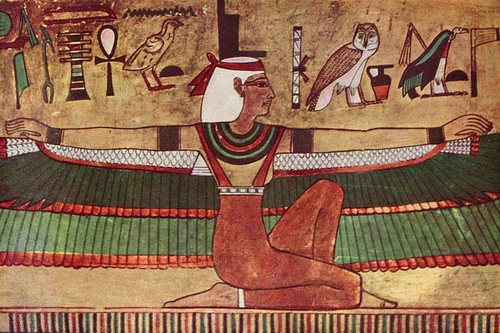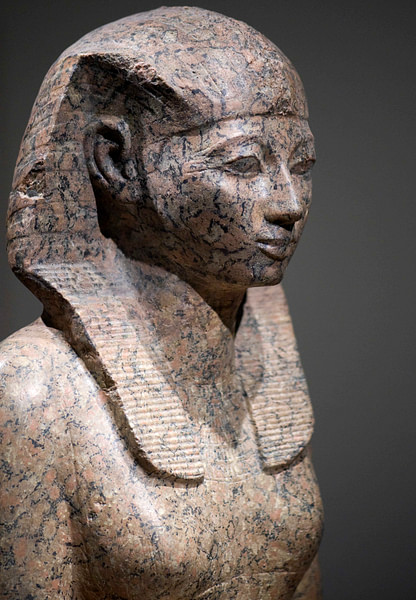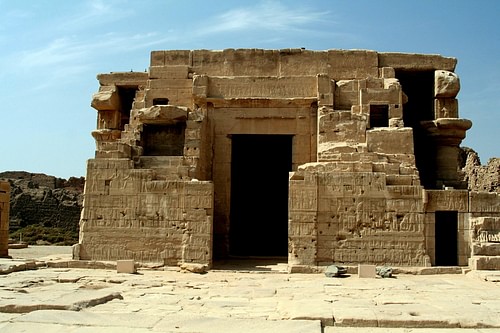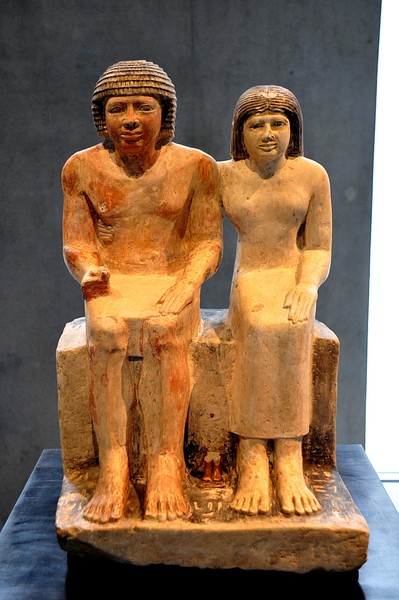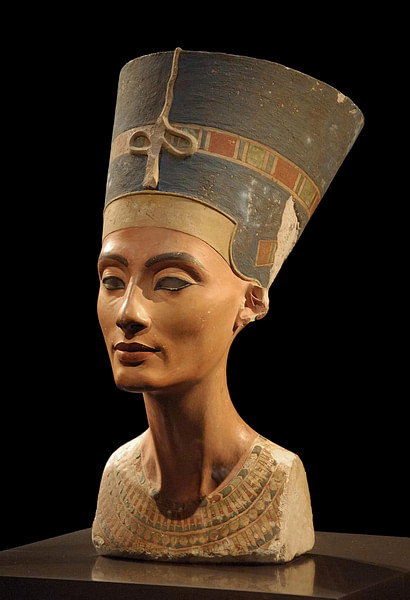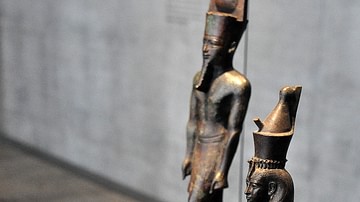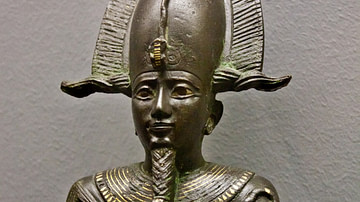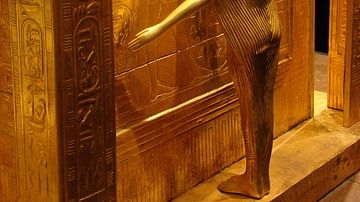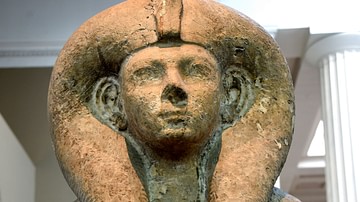One of the central values of ancient Egyptian civilization, arguably the central value, was ma'at - the concept of harmony and balance in all aspects of one's life. This ideal was the most important duty observed by the pharaoh who, as mediator between the gods and the people, was supposed to be a role model for how one lived a balanced life. Egyptian art, architecture, religious practices, even governmental agencies all exhibit a perfect symmetry of balance and this can also be seen in gender roles throughout the history of ancient Egyptian civilization.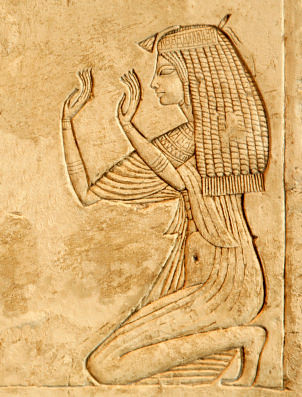
In ancient Egypt a woman enjoyed the same rights under the law as a man. What her de jure [rightful entitlement] rights were depended upon her social class not her sex. All landed property descended in the female line, from mother to daughter, on the assumption, perhaps, that maternity is a matter of fact, paternity a matter of opinion. A woman was entitled to administer her own property and dispose of it as she wished. She could buy, sell, be a partner in legal contracts, be executor in wills and witness to legal documents, bring an action at court, and adopt children in her own name. An ancient Egyptian woman was legally capax [competent, capable]. In contrast, an ancient Greek woman was supervised by a kyrios [male guardian] and many Greek women who lived in Egypt during the Ptolemaic Period, observing Egyptian women acting without kyrioi, were encouraged to do so themselves. In short, an ancient Egyptian woman enjoyed greater social standing than many women of other societies, both ancient and modern. (16)
The respect accorded to women in ancient Egypt is evident in almost every aspect of the civilization from the religious beliefs to social customs. The gods were both male and female, and each had their own equally important areas of expertise. Women could marry who they wanted and divorce those who no longer suited them, could hold what jobs they liked - within limits - and travel at their whim. The earliest creation myths of the culture all emphasize, to greater or lesser degrees, the value of the feminine principle.
The Divine Feminine
In the most popular creation myth, the god Atum lights upon the primordial mound in the midst of the swirling waters of chaos and sets about creating the world. In some versions of this tale, however, it is the goddess Neith who brings creation and, even where Atum is the central character, the primordial waters are personified as Nu and Naunet, a balance of the male and female principles in harmony which combine for the creative act.
Following the creation and beginning of time, women continue to play a pivotal role as evidenced in the equally popular story of Osiris and Isis. This brother and sister couple were said to have ruled the world (that being Egypt) after its creation and to have taught human beings the precepts of civilization, the art of agriculture, the proper worship of the gods. Osiris is killed by his jealous brother Set, and it is Isis who brings him back to life, who gives birth to his child Horus and raises him to be king, and who, with her sister Nephthys and other goddesses such as Serket and Neith, helps to restore balance to the land.
The goddess Hathor, sent to earth as the destroyer Sekhmet to punish humans for their transgressions, becomes people's friend and close companion after getting drunk on beer and waking with a more joyful spirit. Tenenet was the goddess of beer, thought to be the drink of the gods, who provided the people with the recipe and oversaw successful brewing. Shay was the goddess of the written word and librarians, Tayet the goddess of weaving, Tefnut the goddess of moisture. Even the passage of the year was viewed as feminine as personified by Renpet who notched her palm branch to mark the passage of time. The goddess Bastet, one of the most popular in all of Egypt, was a protector of women, of the home, and of women's secrets. Egyptian religion honored and elevated the feminine, and so it is hardly surprising that women were important members of the clergy and temple life.
Women & Religion
The most important position a woman could hold, beginning in the Middle Kingdom of Egypt (2040-1782 BCE), was God's Wife of Amun. There were many "God's Wives" associated with different deities, and initially, in the Middle Kingdom, the God's Wife of Amun was simply one among many. The God's Wife was an honorary title given to a woman (originally of any class but later of the upper class) who would assist the high priest in ceremonies and tend to the god's statue. Throughout the New Kingdom of Egypt (1570-1069 BCE) the position increased in prestige until, by the time of the Third Intermediate Period (1069-525 BCE), the God's Wife of Amun was equal in power to a king and effectively ruled Upper Egypt. During the New Kingdom period, the most famous of the God's Wives was the female pharaoh Hatshepsut (1479-1458 BCE) but there were many other women to hold the office before and after her.
Women could be scribes and also priests, usually of a cult with a feminine deity. The priests of Isis, for example, were female and male, while cults with a male deity usually had only male priests (as in the case of Amun). The high prestige of the God's Wife of Amun is another example of the balance observed by the ancient Egyptians in that the position of the High Priest of Amun was balanced by an equally powerful female.
It must be noted that the designation 'cult' in describing ancient Egyptian religion does not carry the same meaning it does in the modern day. A cult in ancient Egypt would be the equivalent of a sect in modern religion. It is also important to recognize that there were no religious services as one would observe them in the present. People interacted with their deities most completely at festivals where women regularly played important roles such as the two virgins who would perform The Lamentations of Isis and Nephthys at the festivals of Osiris. Priests maintained the temples and cared for the statue of the god, and the people visited the temple to ask for help on various matters, repay debts, give thanks, and seek counsel on problems, decisions, and dream interpretation.
Dreams were considered portals to the afterlife, planes on which the gods and the dead could communicate with the living; they did not always do so plainly, however. Skilled interpreters were required to understand the symbols in the dream and what they meant. Egyptologist Rosalie David comments on this:
In the Deir el-Medina texts, there are references to 'wise women' and the role they played in predicting future events and their causation. It has been suggested that such seers may have been a regular aspect of practical religion in the New Kingdom and possibly even earlier. (281)
These wise women were adept at interpreting dreams and being able to predict the future. The only extant accounts of dreams and their interpretation come from men, Hor of Sebennytos and Ptolemaios, son of Glaukius, (both c. 200 BCE), but inscriptions and fragments indicate that women were primarily consulted in these matters. David continues, "Some temples were reknowned as centres of dream incubation where the petitioner could pass the night in a special building and communicate with the gods or deceased relatives in order to gain insight into the future" (281). The most famous of these was attached to the Temple of Hathor at Dendera where the clergy was largely female.
Occupations of Women
The clergy of ancient Egypt enjoyed great respect and a comfortable living. History from the Early Dynastic Period in Egypt (c. 3150- c. 2613 BCE) through the Late Period of Ancient Egypt (525-332 BCE) abounds in records of the clergy, especially that of Amun, amassing land and wealth. In order to become a priest, one had to first be a scribe, which required years of dedicated study. Once a woman became a scribe she could enter the priesthood, go into teaching, or become a physician. Female doctors were highly respected in ancient Egypt, and the medical school in Alexandria was attended by students from many other countries. The Greek physician Agnodice, denied an education in medicine in Athens because of her sex, studied in Egypt c. 4th century BCE and then returned to her home city disguised as a man to practice.
As the course of study to become a scribe was long and hard, however, not many people - men or women - chose to pursue it. Further, scribes were usually from families of scribes, where great value was placed on literacy and children were expected to follow in their father's or mother's occupation. Women, therefore, were regularly employed as weavers, bakers, brewers, sandal-makers, basket weavers, cooks, waitresses, or as a "Mistress of the House," which today would be an estate owner. When a woman's husband died, or when they divorced, a woman could keep the home and run it as she liked. This aspect of gender equality is almost astounding when one compares it with women's rights over just the past 200 years. A widow living in America in the early 19th century CE, for example, did not have any rights in home ownership and had to depend on a male relative's intercession to keep her home after the death or departure of her husband. In ancient Egypt, a woman could decide for herself how she would make money and keep her estate in order. Scholar James C. Thompson writes:
There were many ways in which a 'Mistress of the House" could supplement her income. Some had small vegetable gardens. Many made clothing. One document shows an enterprising woman purchasing a slave for 400 deben. She paid half in clothing and borrowed the rest from her neighbors. It is likely the woman expected to be able to repay the loan by renting out the slave. Indeed, we have a receipt showing that one woman received several garments, a bull, and sixteen goats as payment for 27 days work by her slave. Those who could not raise the money on their own sometimes joined with neighbors to buy a slave. Women were often part of such a consortium. We know that a woman could inherit and operate a large, wealthy estate. A man who owned such an estate would hire a male scribe to manage it and it would seem reasonable that an heiress would do the same thing. We have little evidence of elite women with paying jobs whether full or part time. (3)
Especially talented women could also find work as concubines. A concubine was not simply a woman who was used for sex but needed to be accomplished in music, conversation, weaving, sewing, fashion, culture, religion, and the arts. This is not to say, however, that their physical appearance did not matter. A request for forty concubines from Amenhotep III (c. 1386-1353 BCE) to a man named Milkilu, Prince of Gezer, makes this clear. Amenhotep III writes:
Behold, I have sent you Hanya, the commissioner of the archers, with merchandise in order to have beautiful concubines, i.e. weavers. Silver, gold, garments, all sort of precious stones, chairs of ebony, as well as all good things, worth 160 deben. In total: forty concubines - the price of every concubine is forty of silver. Therefore, send very beautiful concubines without blemish. (Lewis, 146)
These concubines would have been kept by the pharaoh as part of his harem and, in the case of Amenhotep III, very well kept as his palace at Malkata was among the most opulent in Egypt's history. The king was considered deserving of many women as long as he remained faithful in caring for his Great Wife but, for most of the Egyptians, marriage was monogamous and for life.
Love, Sex, & Marriage
As noted above by Watterson, women were considered legally capable in every aspect of their lives and did not require the supervision, consultation, or approval of a man in order to pursue any course of action. This paradigm applied to marriage and sex as well as any other area of one's life. Women could marry anyone they chose to, marriages were not arranged by the males of the family, and they could divorce when they pleased. There was no stigma attached to divorce even though a life-long marriage was always regarded as preferable. Brier and Hobbs comment on this:
Whether rich or poor, any free person had the right to the joys of marriage. Marriage was not a religious matter in Egypt - no ceremony involving a priest took place - but simply a social convention that required an agreement, which is to say a contract, negotiated by the suitor on the family of his prospective wife. The agreement involved an exchange of objects of value on both sides. The suitor offered a sum called the "virginity gift" when appropriate, to compensate the bride for what she would lose, indicating that in ancient times virginity was prized in female brides. The gift did not apply in the case of second marriages, of course, but a "gift to the bride" would be made even in that case. In return, the family of the bride-to-be offered a "gift in order to become a wife". In many cases, these two gifts were never delivered since the pair soon merged households. However, in the event of divorce, either party could later sue for the agreed gift. (88)
Ancient Egyptian couples also entered into prenuptial agreements which favored the woman. If a man initiated the divorce, he lost all right to sue for the gifts and had to pay a certain sum in alimony to his ex-wife until she either remarried or requested he stop payment. The children of the marriage always went with their mother and the home, unless it had been owned by the husband's family, remained with her.
Birth control and abortions were available to married and unmarried women. The Ebers Medical Papyrus, c. 1542 BCE, contains a passage on birth control: "Prescription to make a woman cease to become pregnant for one, two, or three years. Grind together finely a measure of acacia dates with some honey. Moisten seed-wood with the mixture and insert into the vagina" (Lewis, 112). Even though virginity might have been prized by men initiating marriage, it was not required that a woman be virgin on her wedding night. A woman's sexual experience before marriage was not a matter of great concern. The only admonitions concerning female sexuality have to do with women who tempt men away from their wives. This was simply because a stable marriage contributed to a stable community, and so it was in the best interests of all for a couple to remain together. Further, the ancient Egyptians believed that one's earthly life was only a part of an eternal journey and one was expected to make one's life, including one's marriage, worth experiencing forever.
Reliefs, paintings, and inscriptions depict husbands and wives eating together, dancing, drinking, and working the fields with one another. Even though Egyptian art is highly idealized it is apparent that many people enjoyed happy marriages and remained together for life. Love poems were extremely popular in Egypt praising the beauty and goodness of one's girlfriend or wife and swearing eternal love in phrases very like modern love songs: "I shall never be far away from you/While my hand is in your hand/And I shall stroll with you/In every favourite place" (Lewis, 201). The speakers in these poems are both male and female and address all aspects of romantic love. The Egyptians took great joy in the simplest aspects of life and one did not have to be royalty to enjoy the company of one's lover, wife, family, or friends.
Egyptian Queens & the Lost Gifts of Isis
Still, there is no denying that Egyptian royalty lived well and the many queens and lesser wives who lived in the palace would have experienced enormous luxury. The palace of Amenhotep III at Malkata, mentioned above, extended over 30,000 square meters (30 hectares) with spacious apartments, conference rooms, audience chambers, a throne room and receiving hall, a festival hall, libraries, gardens, storerooms, kitchens, a harem, and a temple to the god Amun. The palace's outer walls gleamed brightly white, while the interior colors were a lively blue, golden-yellow, and vibrant green. The women who lived in such palaces experienced a life far above that of the lower classes but still had their duties to fulfill in keeping with ma'at.
Egyptologist Sally-Ann Ashton writes, "In a world that was dominated by the male pharaoh, it is often difficult to comprehend fully the roles of Egyptian queens. A pharaoh would have a number of queens but the most important would be elevated to "principal wife" (1). The role of the principal or great wife varied with the pharaoh. In the case of Queen Tiye (1398-1338 BCE), the wife of Amenhotep III, she regularly took part in the affairs of state, acted as a diplomat, and even had her name written in a cartouche, like a king. Nefertiti (c. 1370-1336 BCE), the wife of Akhenaten, cared for their family while also helping her husband run the country. When her husband essentially abandoned his duties as pharaoh to concentrate on his new monotheistic religion, Nefertiti assumed his responsibilities.
Great queens are recorded as far back as the Early Dynastic Period in Egypt with Queen Merneith (c. 3000 BCE) who ruled as regent for her son Den. Queen Sobeknefru (c. 1807-1802 BCE) took the throne during the Middle Kingdom of Egypt and ruled as a woman without regard for the trappings of tradition that only a male could reign over Egypt. Hatshepsut of the 18th Dynasty took Sobeknefru's example further and had herself crowned pharaoh. Hatshepsut continues to be considered one of the most powerful women of the ancient world and among the greatest pharaohs of Egypt.
Although female rulers are in the minority in ancient Egypt, powerful queens are not. Their duties and many of their activities remain undocumented or, at least, untranslated, but there is no doubt - based on the information that is available - that these women exerted considerable influence over their husbands, the court, and the country.
In the beginning of time, when Osiris and Isis ruled over the world in peace and justice, Isis is said to have given gifts to humanity and, among them, the gift of equality between men and women. This Egyptian legend is exemplified by the high status women enjoyed throughout Egypt's history. Brier and Hobbs note how "the status of women in Egypt was incredibly advanced for the time" (89). This is no doubt true, but one could argue that women's status was incredibly advanced for any time in world history, including the present. A woman in ancient Egypt had more rights than many women living in the present day.
Equality and respect for women continued through the Ptolemaic Dynasty (323-30 BCE), the last to rule Egypt before it was annexed by Rome. Cleopatra VII (c. 69-30 BCE), the last queen of Egypt, is among the best representatives of women's equality as she ruled the country far better than the males who preceded her or thought to co-rule with her. Women's status began to decline in Egypt with the rise of Christianity in the 4th century CE and its belief that sin had entered the world through Eve's disobedience and that women were of less value and less to be trusted than men. The Arab Invasion of the 7th century CE brought Islam to Egypt and effectively ended the kind of equality women had known in the country for almost 3,000 years.
